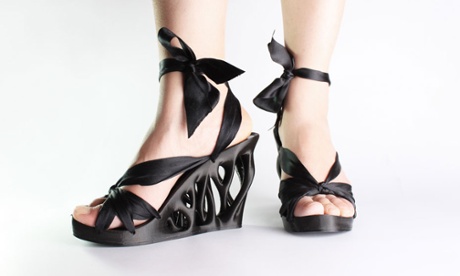
1. 3D printed textiles are still very beta
While there have been advances in terms of materials used in 3D printing (nylon for example can be combined with wood or bronze), more flexible materials are still in beta or prototype stages.
Brooklyn-based designer Xuedi Chen has experimented with flexible 3D printed fabric, but the materials she's tested have been too strong and rubber-like. Equally, designer Iris Van Herpen, who debuted two 3D-printed outfits at Paris Fashion Week last year, cited a similar challenge in a recent interview with Guardian Sustainable Business: "If you look at the flexible materials that are being printed in fashion now, they feel like a brick compared to cotton or wool." Electroloom however, is facing the opposite problem - the wispy quality of its prototype fabrics means they're currently not durable for frequent wear.
But there are currently some incredible advances happening in resolution, according to Gert Jan Spriensma, founder and CEO of tech and 3D printing jewellery company Zazzy.
Nylons can be printed at 50-60 microns (one micron is equivalent to a millionth of a metre) while if you're using wax you can print in 30 micron layers. Combine it with polishing and you will see almost no print lines anymore.
The race is on to reach nano, (one micron is equivalent to 1,000 nanometers) and once nano level has been achieved, Jan Spriensma predicts amazing things.
2. In the future we'll wash less
Along with irrigating cotton fields, washing clothes at home is one of the most water demanding aspects of clothing. If we can reduce the number of washes required, we can reduce the amount of water consumed. To this end, Han Kuilderd, textile industry technology manager at Novozymes, explains that there are finishes being looked into to make this possible. While the antibacterial technology for textiles already exists and many retailers are coating their garments in silver technology (silver has natural antibacterial qualities) - at present it can only last for around 15 washes.
In 2003, Samsung revealed its silver sterilisation washing machine, which it claims can cover a laundry load with silver nano-particles and remove bacteria without bringing the water to a boil, meaning less electricity is required to achieve the same hygienic effect. Friends of the Earth, however, has been critical of the machine and the environmental risks and benefits of silver nanotechnologies are still debated.
3. Our bodies could become mobile battery banks
"In terms of energy harvesting off the body I think wearable technologies can raise awareness [of environmental issues] and provide a practical solution at the same time," says PhD student, Martijn ten Bhömer. We're already seeing some of the potential in fitness trackers, but Chen believes we can use the body more as an energy harvesting vehicle and mobile battery bank.
An example of this comes from designer, Damon Ahola, who has devised Harvest, a micro rechargeable lithium-ion battery embedded in footwear or kept in pockets that transforms the user's movements into quantifiable energy that could eventually be uploaded and stored to a green energy bank.
Ahola writes:
With the current energy-harvesting technology today, the amounts of energy possible are quite small. Though there has been a lot more attention on it recently and the military has been developing an energy-harvesting boot to charge all of the batteries soldiers carry with them.
4. Technology will rebuild supply chains
Looking at technology from a big data viewpoint, the fashion industry is going to get a lot more transparent. Consumers will be able to see where their clothes are made, where and by whom. In this sense, factories will have to become more sustainable since their practices will be more public facing. - Damon Ahola.
5. Science is making natural fibre breakthroughs
Novozymes' Kuilderd believes we should look more into fibres such as linen and hemp which unlike cotton, don't require irrigation or pesticides. He explains that work is underway to make these fibres even better while writer and sustainable fashion consultant Amy DuFault points to the work of the Future Resource Collective, a team working with technology to break apart and reuse natural fibres to create new fibres. This comes as scientists at Stockholm's Royal Institute of Technology reveal they have developed a way of recreating cotton.
While some synthetic fibres appear more sustainable than those we consider natural - for example nylon and polyester are more sustainable than cotton when it comes to dyeing - it's necessary to assess the journey from field to landfill before determining what makes one fibre more sustainably sound than another. As Ella Peinovich, founder of Soko points out:
There is so much more to 'being sustainable' than just environmental sustainability ... [there is] cultural sustainability and employment sustainability (ie weaver and loom populations around the world); in addition to sustainably sourced materials.
The sustainable fashion hub is funded by H&M. All content is editorially independent except for pieces labelled advertisement feature. Find out more here.
Join the community of sustainability professionals and experts. Become a GSB member to get more stories like this direct to your inbox

